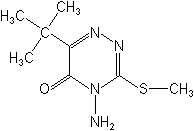| Common
Name: |
Metribuzin
|
| Chemical
Name: |
4-amino-6-tert-butyl-4,5-dihydro-3-methylthio-1,2,4-triazin-5-on
|
| CAS
No.: |
21087-64-9
|
Structure: |
 |
| Molecular
Formula: |
C8H14N4OS
|
| Molecular
Weight: |
214.29
|
| Physical
Chemistry: |
Metribuzin is a white, crystalline solid with a slightly sharp, sulfurous odor. Water Solubility: 1050 mg/L. Solubility in Other Solvents: s. in aromatic and chlorinated hydrocarbon solvents, including dimethyl formamide, cyclohexane, methanol, benzene, ethanol, xylene, and kerosene.Melting Point: 125-126.5 C. Vapor Pressure: 0.058 mPa @ 20 C. Partition Coefficient:1.6021 . Adsorption Coefficient: 60.
|
| Toxicity: |
Metribuzin is slightly toxic via the oral route, with reported oral
LD50 values of 1090 to 2300 mg/kg in rats, 700 mg/kg in mice and 245
to 274 mg/kg in guinea pigs. It is practically nontoxic dermally,
with a dermal LD50 of 20,000 mg/kg in rabbits. The 4-hour inhalation
LC50 for metribuzin in rats is greater than 0.65 mg/L, indicating
moderate toxicity via the inhalation route. Metribuzin has been
shown not to irritate the skin or eyes of rats, rabbits, guinea
pigs, or human volunteers.
|
| Application: |
Metribuzin is a selective triazine herbicide which inhibits photosynthesis of susceptible plant species. It is used for control of annual grasses and numerous broadleaf weeds in field and vegetable crops, in turfgrass, and on fallow lands.
|
| Technical
Purity: |
95%Tech
|
| Formulation
Type: |
75%WDG,70%WP,48%SC
|
|



